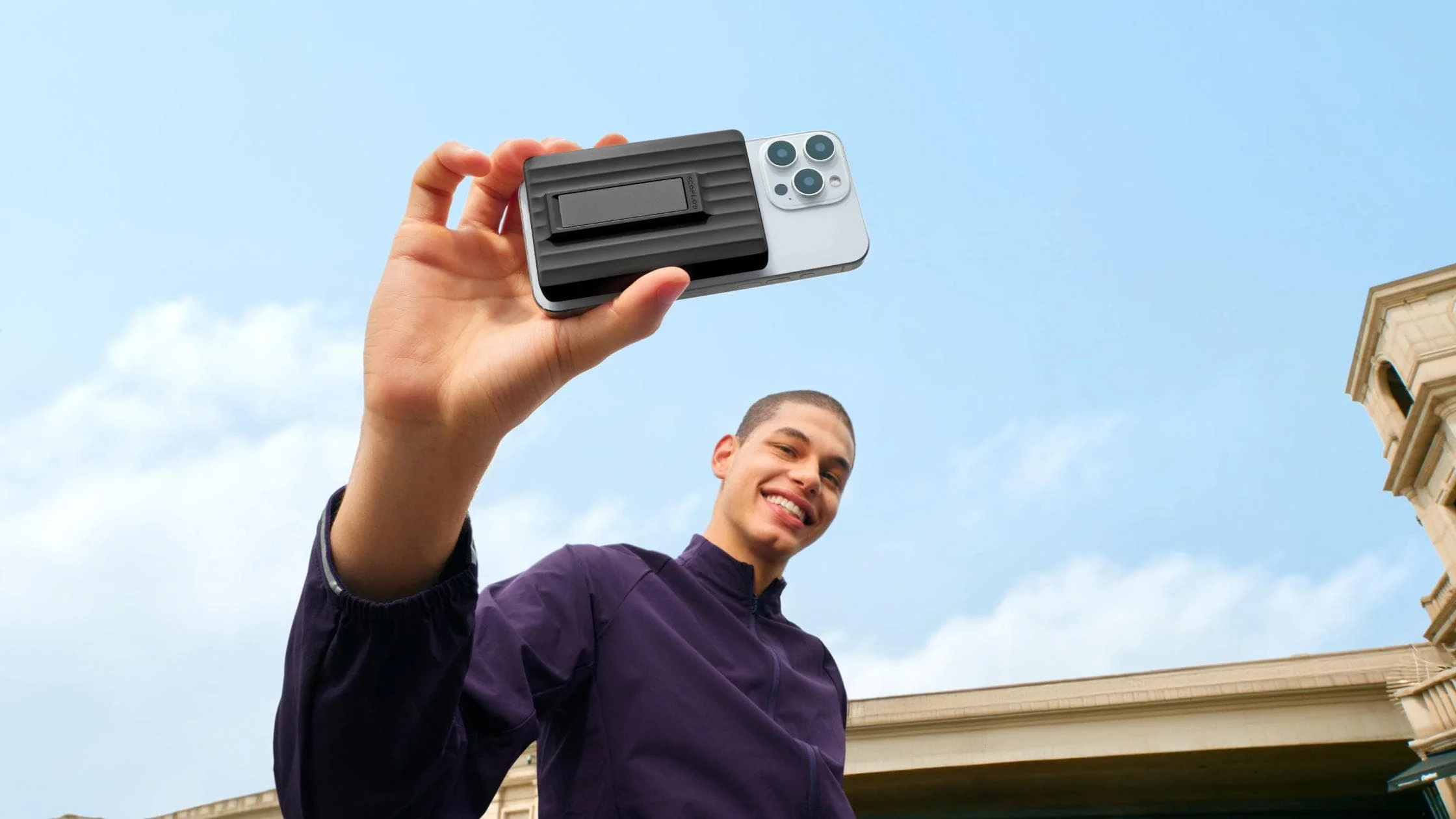- Can a Magnetic Power Bank Interfere With Your Credit Cards?
- Why a Magnetic Power Bank Impacts Some Cards
- How Strong Does a Magnet Have to Be to Damage a Credit Card?
- Are There Other Impacts from a Magnetic Power Bank?
- What to Do to Avoid Any Negative Impacts
- Choose a Magnetic Power Bank That Solves the Problems
- Keep Cards Safe While Wireless Charging
- FAQs About Magnetic Chargers and Devices
Can a Magnetic Power Bank Interfere With Credit Cards on My Desk?
- Can a Magnetic Power Bank Interfere With Your Credit Cards?
- Why a Magnetic Power Bank Impacts Some Cards
- How Strong Does a Magnet Have to Be to Damage a Credit Card?
- Are There Other Impacts from a Magnetic Power Bank?
- What to Do to Avoid Any Negative Impacts
- Choose a Magnetic Power Bank That Solves the Problems
- Keep Cards Safe While Wireless Charging
- FAQs About Magnetic Chargers and Devices
We’ve all heard warnings about keeping magnets and bank cards separate. Can a magnetic power bank really damage or demagnetize them?
The short answer is: it’s extremely unlikely to harm your credit cards. But the "why" is important, and the answer is different for other items in your wallet, like hotel key cards.
Let’s look at the facts.
Can a Magnetic Power Bank Interfere With Your Credit Cards?
Most of the time, clearly no. Sometimes, yes.
No, if Your Card Has a Chip
Credit or debit cards issued in the last ten to fifteen years each have a small EMV chip on the front. This chip is a tiny, secure microcomputer. It stores your data in an encrypted, digital format, much like a miniature flash drive.
Magnets do not affect it. You could place a magnetic power bank directly on the chip, and it would still work perfectly. Your card's "tap-to-pay" or contactless (NFC) function is also a form of radio communication that magnets cannot damage.
Yes, if the Card is Old... or a Hotel Key
A magnetic power bank could interfere if:
It’s a hotel key card. This is the number one reason this myth exists. People frequently find their hotel key cards are suddenly blank after being in the same pocket as their phone or a magnetic wallet.
It’s a paper transit ticket or parking garage ticket. Many disposable-use cards use an extremely weak and erasable magnetic stripe.
You "sandwich" the card. Experts warn not to place credit cards between your phone and a wireless charger. This isn't about the static magnets. It's about the powerful electromagnetic induction field that forms during the charging process, which could theoretically scramble a stripe.
Why a Magnetic Power Bank Impacts Some Cards
The answer is simple: cards use different types of magnetic stripes, and some are much weaker than others.
Black Stripe (HiCo - High Coercivity): Your credit cards, debit cards, and driver's license have this type. The black color indicates a very strong magnetic stripe that's extremely hard to erase. A magnetic power bank isn't powerful enough to damage it.
Brown Stripe (LoCo - Low Coercivity): Hotel keys, gift cards, and parking tickets use this weaker version. The light brown color is your clue. These stripes are intentionally made weak so they can be rewritten easily. But that also means a magnetic power bank can erase them.
In all, your magnetic power bank can't wipe your black-stripe credit card. But it can easily erase your brown-stripe hotel key.
How Strong Does a Magnet Have to Be to Damage a Credit Card?
Let's put some hard numbers to this. We measure magnetic strength in a unit called gauss. The higher the gauss, the stronger the magnet.
A Low-Coercivity (LoCo) hotel key (the brown stripe) can be wiped by a magnetic field as weak as 300 gauss.
A High-Coercivity (HiCo) credit card (the black stripe) requires a much, much stronger field to be damaged—around 4,000 gauss.
So, how strong are the magnets in a magnetic wireless power bank? Typically around 50 to 200 gauss at the surface. And the data makes the conclusion pretty clear.
Are There Other Impacts from a Magnetic Power Bank?
Great, now we know our credit cards are safe. But what about all the other electronics on our desk or in our pockets?
For Your Phone's NFC (Tap-to-Pay)
A magnet will not damage your phone's NFC chip. But the magnets and metal in the power bank can block the NFC signal, causing a "failed tap". This is especially common on some Android phones where the NFC antenna is located near the charging coil.
Fix: Just remove the power bank before you tap, and it will work fine.
For Wi-Fi and Cellular Signals
Similar to NFC, the metal in a power bank can slightly reduce your signal strength. Some users report "network instability" or Wi-Fi dead zones when using bulky magnetic cases.
The effect is temporary and will vanish when you remove the accessory.
For Your Phone's Compass
Yes, a magnet will absolutely interfere with your phone's compass. A compass, by definition, finds magnets. It's built to point to the Earth's (very weak) magnetic field.
When you put a strong magnet next to it, the compass will simply point to that instead.
But this is not damage either! The compass will recalibrate and return to normal as soon as you remove the power bank.


For Laptops (HDD vs. SSD)
This one is important.
Modern Laptops (with SSDs): If you have a modern laptop (from the last 5-7 years), it uses a Solid State Drive (SSD). SSDs are flash memory (like your phone) and are 100% immune to magnets.
Older Laptops (with HDDs): If you have an older laptop or an external hard drive that uses a spinning Hard Disk Drive (HDD), the risk is very real. An HDD stores data on spinning magnetic platters, and a strong magnet can permanently destroy that data.
Rule of Thumb: Keep magnetic power banks far away from old-style external hard drives.
CRITICAL WARNING: For Pacemakers and ICDs
The magnets in consumer electronics, including a magnetic power bank for iPhone, can pose a serious risk to anyone with a pacemaker or an Implantable Cardioverter-Defibrillator (ICD).
These life-saving medical devices can have a "magnet mode" that a nearby magnet can trigger. This can stop an ICD from delivering a life-saving shock.
The non-negotiable medical advice from experts like the American Heart Association is to keep all such electronics at least 6 inches (15 cm) away from the implant site. When the device is wirelessly charging, the recommended safety distance increases to at least 12 inches (30 cm).
What to Do to Avoid Any Negative Impacts
Here’s a simple checklist to ensure you never have a problem:
DO keep hotel keys, parking tickets, and cheap gift cards in a separate pocket from your phone and magnetic power bank.
DON'T ever "sandwich" a card with a magnetic stripe between your phone and the power bank while it’s actively charging.
DO simply remove your power bank for a moment if you're using "tap-to-pay" and it fails.
DON'T place your power bank on or near an older external hard drive (HDD).
DO strictly follow the 6-inch (static) and 12-inch (charging) safety rule if you or someone nearby has a pacemaker or ICD.


Choose a Magnetic Power Bank That Solves the Problems
We've shown that the magnets in a power bank aren't a risk to your important cards. The real safety concern for any power bank, magnetic or not, is heat.
The CPSC has issued recalls for power banks from various brands precisely because their lithium-ion batteries can overheat and ignite. A poorly made charger can also damage your phone's battery health over time due to excess heat.
This brings us back to the main topic: the magnets. In a well-designed magnetic power bank, the magnets are the first line of defense against heat. Their job is to ensure perfect alignment between the charger's coil and your phone's coil. This perfect alignment is the key to a highly efficient charge. Why does that matter? Because inefficiency and poor alignment waste energy, and that wasted energy escapes as excess heat.
This is why we focused on total safety and smart design when building the EcoFlow RAPID Mag Power Bank.
It uses magnets for safety, not just convenience. The RAPID Mag is built around this principle. Its powerful, 11N N54 magnets snap your phone into the perfect position every time, maximizing charging efficiency and minimizing the heat that causes battery damage.
It actively manages its own temperature. The power bank doesn't stop there. It features EcoFlow's X-Cooling technology, an advanced system that performs real-time temperature checks to ensure the power bank stays at a safe, cool temperature (under 107.6°F). This protects both its own battery and your phone's long-term health.
This focus on smart, safe design extends to the whole experience. You get power you can see on a bright, high-definition LCD screen that shows the exact percentage remaining. You get convenience that's always ready with a durable, built-in USB-C lanyard cable. And you get hands-free function with a sturdy, stainless steel adjustable kickstand for video calls or watching movies. It's a complete, safe, and reliable charging solution built to solve the real issues.
Keep Cards Safe While Wireless Charging
So, can a magnetic power bank interfere with your credit cards? For your modern, chip-enabled cards, the answer is a clear "no." You can easily avoid the minor risks (like wiping a hotel key), and the real safety factor to watch for is heat, not magnets. That's why choosing a power bank with advanced safety and thermal controls, like the EcoFlow RAPID Mag, is the smartest way to get the power you need with the peace of mind you deserve.
FAQs About Magnetic Chargers and Devices
Q1: Can magnets ruin credit cards?
Most of your fear is outdated. These days, credit cards have a safe chip that magnets can't hurt. A weak hotel key card and an old parking ticket are the real problems. It's possible for the weak magnets in your charger to erase those, but not your real bank card.
Q2: Why does tap-to-pay fail with a magnetic charger attached?
The "tap-to-pay" (NFC) chip is not hurt by the magnets. Metal inside the magnetic power bank can act as a shield, stopping the phone from sending the radio signal it needs to. It will work properly again as soon as you take the charger off.
Q3: Should I keep magnetic chargers away from old laptops?
Yes, absolutely. If your laptop is more than seven years old, it may have an old-style hard drive (HDD) that spins. A strong magnet can easily and permanently delete your data from these drives because they store data magnetically. Keep these older devices and magnetic items far away from each other.
Q4: Is heat more dangerous than magnets for phones?
Of course. The magnets won't really hurt your phone's battery. A bad charger, on the other hand, can damage the battery over time with too much heat, shortening its life. Good magnetic chargers keep coils perfectly aligned and cool to avoid overheating.
Q5: Will a magnetic charger permanently damage my phone's GPS?
No, the result is only temporary and harmless. The strong magnet only tricks the compass on your phone so that it points at the charger instead of the Earth. When you take the power bank out, the compass restarts and re-calibrates itself right away, and you can continue navigating normally.